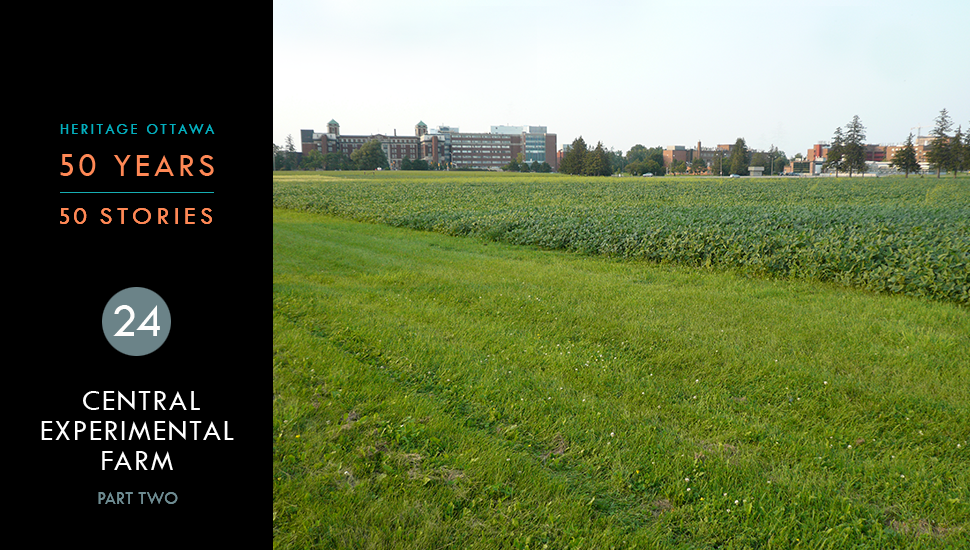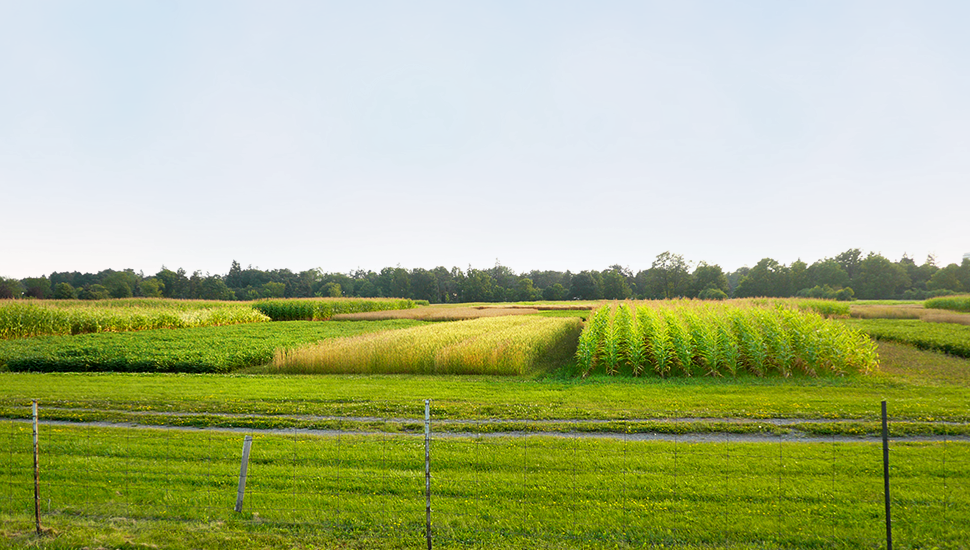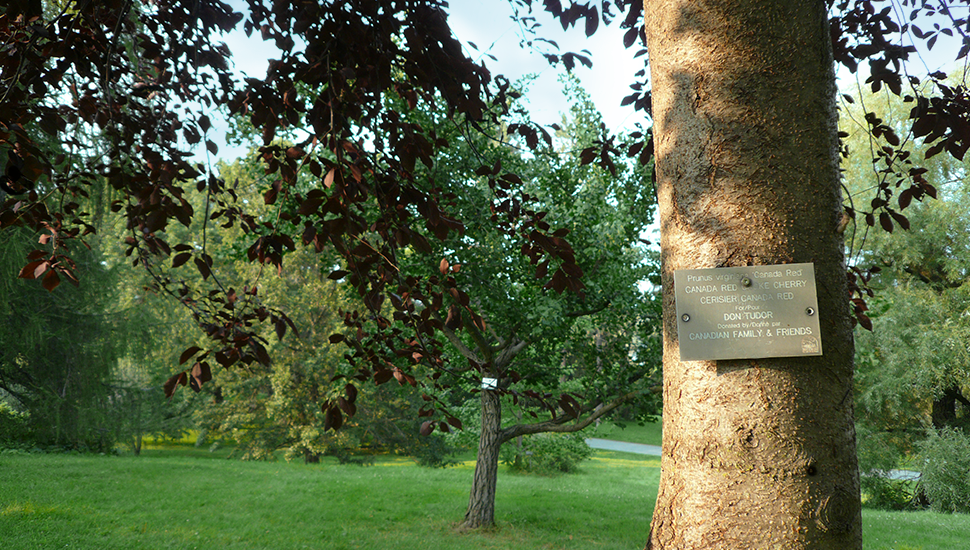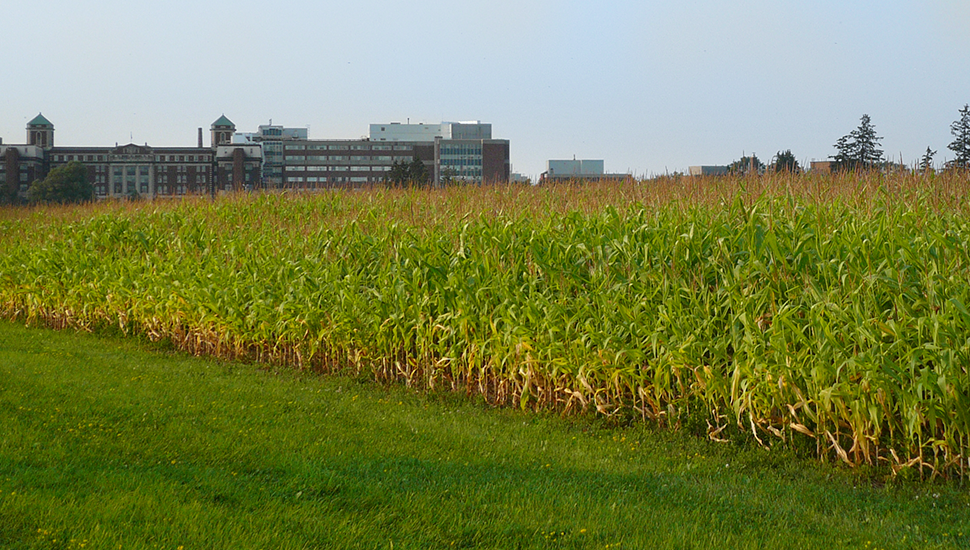24. Central Experimental Farm: Part 2
Construction: Established in 1886
Architects: Various
Location: A rectangular parcel of land over 400 hectares in area bounded by Carling Avenue to the north, Baseline Road to the south, Fisher Avenue to the west, and by the Rideau Canal and Prince of Wales Drive to the east.
The designation of the Central Experimental Farm (CEF) as a National Historic Site in 1998 was a watershed moment in the Farm’s history. With its scientific importance internationally recognized, its key role in securing Canada’s food security confirmed, and its overall importance to the agricultural sector established, ongoing threats to the Farm were an unexpected development.
In 2002-2003, the Ottawa Botanical Garden Society launched a campaign to develop a large swath of research land to the south of the arboretum as a botanical garden, complete with paved parking and infrastructure to accommodate large tours. Heritage Ottawa was joined by landscape architects and others in successfully opposing the proposal.
In 2007-2008, the Ottawa Hospital started planning to replace the elderly Civic Campus. Built in 1924, the Civic had expanded over the years with ad hoc upgrades and additions. The Hospital board determined that an entirely new structure was necessary, and that further expansion on site would be too complicated and costly. Board members focused their attention across Carling Avenue to Research Field #1, and approached Agriculture and Agri-Foods Canada (AAFC) about obtaining it. Then Minister of AAFC, Gerry Ritz, replied with a firm no.
In November, 2014, Heritage Ottawa learned of a renewed threat to the CEF. The Minister of Foreign Affairs, John Baird, (also responsible for the NCC), unexpectedly announced the gift of 60 acres of prime research land to the Ottawa Hospital for a new campus. Field #1, crucial to the scientific work on the CEF, was to be paved over.
Heritage Ottawa responded quickly, working to establish the Coalition to Protect the Central Experimental Farm. Partners and supporters included the Greenspace Alliance for Canada’s Capital, the Agricultural Institute of Canada, the National Trust, the National Farmers’ Union, scientists internationally, and many others.
The goal was to find a solution that would provide the Ottawa Hospital with a suitable site while leaving the research function of the CEF intact. With Ottawa’s large land base, there was no reason not to have both. While the Hospital listened sympathetically to Heritage Ottawa’s position, its board determined that Field #1 remained the best site.
Heritage Ottawa and the Coalition were relentless. Letters were written, meetings set up with decision-makers and influencers, a “Protect the Farm” Facebook page launched, and articles and letters published on the Heritage Ottawa website, which before long built up a national and international following.
Eventually the federal government acknowledged that the issue was too important to be decided by ministerial fiat. The National Capital Commission (NCC) was tasked with examining federal lands in the central area of Ottawa superfluous to government needs that would be suitable for a hospital site. Public consultations were well attended and included representatives from the farming community, research biologists, heritage advocates and concerned citizens. Feelings ran high.
On November 28, 2016, after thorough deliberation, the NCC identified Tunney’s Pasture as the best overall site. Just four days later the the Ottawa Hospital (TOH) board announced its rejection of that recommendation.
On December 2, Mayor Jim Watson convened a meeting that included 17 elected area MPPs and MPs. The group flipped the NCC’s recommendation to a 25-hectare parcel of land at the northeast corner of the Farm along Carling Avenue near Dow's Lake that includes the land where the former Sir John Carling Building once stood (see Master Site Plan for full description). This "compromise" meant the hospital would get a portion of the Farm without disturbing agricultural research lands.
The then Minister of Heritage, Melanie Joly, removed the designation from a 42-acre portion of the Farm. Subsequently, Public Works executed a 99-year lease of the property to TOH for the sum of $1 per annum.
The research lands were saved, but the implications for heritage conservation of this unique picturesque landscape in the heart of urban Ottawa are significant and Heritage Ottawa has remained vigilant in its commitment to protect this special place.
There is still a proposal to sever some 30-odd acres between Prince of Wales Drive and the Rideau Canal for the proposed botanical garden (the Farm already has a botanical garden).
Heritage Ottawa regrets that any piece of the CEF will be lost to development, leaving large portions of what remains of the Farm vulnerable.
Decisions regarding details of the site’s development are ongoing and Heritage Ottawa continues to work to protect the CEF, a treasured National Historic Site in the heart of the city.
See also: 50 Years | 50 Stories # 23. Central Experimental Farm: Part 1
Related Reading:
Central Experimental Farm National Historic Site: Impact of New Ottawa Hospital
Central Experimental Farm's Management Plan Should Be Respected
The Heritage Ottawa website includes approximately 100 articles chronicling efforts to protect the CEF. To read more, enter "Central Experimental Farm" in the search field at upper right of this page.
Threats to the Farm remain. Follow developments on Heritage Ottawa's website and social media, and at www.facebook.com/protectthefarm.





